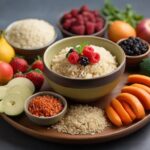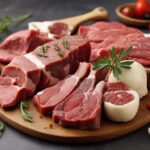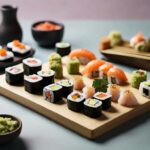In the pursuit of a healthier and more ethical diet, many people opt to adopt a vegan lifestyle. However, a common concern among those considering this lifestyle is whether they can obtain enough protein without consuming animal products. In this article, we will explore in detail how to ensure an adequate protein intake in a vegan diet, including practical strategies and a wide range of plant-based food sources rich in protein.
Importance of Protein in a Vegan Diet
Protein is an essential nutrient that plays numerous vital roles in the human body. It is not only responsible for tissue repair and construction but also crucial for the production of enzymes, hormones, and antibodies, as well as for maintaining cellular structure and muscle health. Although protein has traditionally been associated with animal-derived foods, it’s important to understand that it’s entirely possible to meet protein needs through plant sources.
Strategies to Ensure Adequate Protein Intake
Diversification of Protein Sources
One key to obtaining enough protein in a vegan diet is to diversify food sources. Incorporating a wide variety of legumes, grains, nuts, seeds, and soy products ensures that all essential amino acids necessary for optimal body function are obtained.
Combining Complementary Foods
While it’s not necessary to worry about combining specific foods at every meal, it’s helpful to consider the complementarity of certain foods to ensure a complete amino acid profile. For example, combining legumes with whole grains, such as brown rice or quinoa, creates a complete and balanced protein.
Incorporating Protein Sources in Every Meal
It’s important to plan meals to include a source of plant-based protein in every dish. Legumes, tofu, tempeh, nuts, seeds, and other protein-rich plant products should take center stage in main meals and snacks to ensure an adequate protein intake.
Using Vegan Protein Supplements
In cases where it’s challenging to obtain enough protein through diet alone, vegan protein supplements can be a useful tool. These products, made from plant sources such as peas, rice, hemp, or soy, provide a convenient way to increase daily protein intake.
Exploring New Recipes and Culinary Techniques
Vegan cuisine offers a wide variety of creative and delicious options for increasing protein intake. Experimenting with new recipes and culinary techniques can help discover new ways to enjoy protein-rich foods, such as protein shakes, marinated soy dishes, legume burgers, and more.
Protein Sources in a Vegan Diet
Legumes
Legumes, including beans, chickpeas, lentils, and peas, are one of the best sources of plant-based protein. They are rich in fiber, iron, and other essential nutrients and can be prepared in countless ways, from soups and stews to burgers and salads.
Tofu and Tempeh
Tofu and tempeh are versatile and highly protein-rich soy products. Tofu, with its soft and neutral texture, is excellent for absorbing flavors and can be used in a wide variety of dishes, from scrambles to desserts. Tempeh, with its firmer texture and nutty flavor, is ideal for grilling, frying, or crumbled in sautéed dishes.
Seitan
Also known as “wheat meat” or “wheat gluten,” seitan is an excellent protein source for vegans. Made from wheat gluten, this versatile food has a chewy texture and can be seasoned and cooked in many different ways, from roasts and stews to steaks and meatballs.
Soy Products
In addition to tofu and tempeh, there is a wide variety of soy-derived products that are protein-rich, such as soy milk, soy yogurt, soy cheese, and soy meat (also known as “soy-textured protein”). These products are excellent options for those looking to increase their protein intake without resorting to animal-derived foods.
Nuts and Seeds
Nuts and seeds are a rich source of protein, healthy fats, fiber, and a variety of other essential nutrients. Almonds, walnuts, pistachios, sunflower seeds, pumpkin seeds, chia seeds, and hemp seeds are just some of the available options that can be added to shakes, salads, cereals, and baking recipes to increase protein intake.
Whole Grains
Whole grains, such as brown rice, quinoa, bulgur, barley, and oats, are an important source of protein in the vegan diet. In addition to providing protein, these whole grains are also rich in fiber, vitamins, minerals, and antioxidants, making them a nutritious addition to any meal.
Leafy Green Vegetables
Some leafy green vegetables, such as spinach, kale, Swiss chard, and broccoli, also contain significant amounts of protein, in addition to a variety of other health-beneficial nutrients. These vegetables are versatile and can be used raw in salads, sautéed, steamed, or added to soup and stew dishes.
Fortified Vegan Products
Many vegan food products, such as plant-based milks, breakfast cereals, energy bars, and nutritional supplements, are fortified with protein and other nutrients to meet the needs of vegans. These products can be a convenient option for those looking to increase their protein intake without resorting to animal-derived foods.
Conclusion
In summary, obtaining enough protein on a vegan diet is entirely feasible with proper planning and smart food choices. By diversifying protein sources, combining complementary foods, and exploring new recipes and culinary techniques, vegans can easily meet their protein needs and enjoy a balanced and nutritious diet that supports their long-term health and well-being. It’s important to remember that variety and moderation are key, and it’s always advisable to consult with a healthcare professional or registered dietitian if you have specific concerns about your protein intake or any other aspect of your vegan diet.
Explore our e-shop and take your culinary experience to the next level! At Cooking Landia, we have carefully selected the finest kitchen utensils and products for you. From high-quality chef’s knives to durable cookware, and innovative culinary gadgets, you’ll find everything you need to equip your kitchen like a true professional. Discover our curated collection and choose the products that will make cooking even more exciting and efficient. Visit our e-shop now and turn every moment in the kitchen into an extraordinary experience! 🍳🔪🍴
More content
- 10 Latin American Sweets: Tempting Dessert Adventures Await

- 15 Foods to Maintain a Balanced and Nutritious Diet

- 5 Great Gastronomic Moments: Historic Milestones in the Cuisine

- 6 Healthy Recipes for a Balanced and Delicious Diet

- A Gastronomic Journey: Migratory Influences in the Cuisine

- Art of Fruit and Vegetable Cutting: Expert Techniques Revealed

- Boost Your Immune System: The Best 10 Foods

- Comida Callejera en el Mundo: Historia y Platos Típicos

- Complete Guide to Cooking Methods: Everything You Need to Know

- Complete Guide to Gluten-Free Diets: Tips for Beginners

- Complete Guide: Enhance Your Dishes with Fresh Herbs

- Culinary Globalization: Exploring 6 Iconic World Dishes

- Culinary Innovations: The Most Impactful Gastronomic Trends

- Culinary Journey: Discovering Culinary Traditions from Different Cultures

- Culinary Secrets Unveiled: Elevate Your Cooking with Simple Ingredient Tricks

- Dietary Plans for Food Allergies: Top 10 Tips and Recommendations

- Easy Gluten-Free Recipes for Every Day of the Week

- Efficiency Unleashed: Explore the Art of Mise en Place

- Exploring Flavors: Top 10 Typical Dishes of Latin America

- Flavors of the World: A Journey Through Diverse Culinary Influences

- From Farm to Table: How to Select Quality Meat

- From Fusion to Tradition: 4 Global Gastronomic Trends

- Gastronomía egipcia: dieta y recetas ancestrales

- Gastronomy and Folklore: Culinary Traditions and Local Myths

- Healthy and Affordable Recipes: Eating Well Without Spending Much

- Healthy Breakfasts: 7 Nutritious Recipes for the Whole Week

- Historia del Chocolate: De los Aztecas al Presente

- Homemade Sushi: Simple Steps to Prepare Your Favorite Rolls

- How to Choose the Best Poultry for Your Recipes

- Iconic Dishes of Spanish Cuisine by Region

- Innovation in Cuisine: Gourmet Products in Traditional Recipes

- Low-Carb Diet: A Beginner’s Guide

- Low-Carb Diets: Top 10 Recommended Foods

- Master Your Kitchen: 10 Unexpected Tips for Easy Cooking

- Mastering Healthy Cooking: Unveiling 4 Low-Fat Secrets

- Menus for Allergen-Free Diets: The Best Recipes and Nutritional Strategies

- Myths and Legends: The Magical Stories Behind Foods

- Perfect Pairing: Wines and Dishes for Gastronomic Celebrations

- Probiotic Foods: How Do They Improve Your Digestive Health?

- Protein Sources in a Vegan Diet: What to Do?

- Revealing the Superfood Potential of Red Fruits: Benefits & Recipes

- Secrets of Asian Cuisine: Discovering 8 Traditional Techniques

- Secrets of Latin American Cuisine: Traditional and Authentic Recipes You Must Try

- Simple Mediterranean Cooking for Beginners: Impress Your Guests!

- Spices Through Time: Understanding Their Historical Importance

- Starting Out in the Kitchen: Pro Chef Tips for Beginners

- Sustainable Dishes: Gastronomic Trends for a Greener Future

- Symbolism of Food: The Meaning in Every Bite

- Taste of the Mediterranean: 5 Key Dishes

- Taste the Best of Africa: Top 5 Iconic Regional Recipes

- The 10 Most Exclusive Gourmet Products You Must Try

- The Evolution of Food: Traditional vs. Modern Cuisine Compared

- The Great Masters of Cuisine: Contributions to its Evolution

- The Most Impactful Gastronomic Trends Shaping the World

- The Secrets of African Cuisine: Traditional Recipes and Flavors

- The Secrets of Perfect Seafood Cooking: Kitchen Tricks

- Title: Culinary Traditions in Festivals: Festive Flavors of the World

- Unlock Your Culinary Potential: Beginner’s Guide to Essential Techniques

- Vegetarianism for Beginners: Simple Steps to Adopt This Lifestyle

- White Fish vs. Blue Fish: Which is Better for Your Health?


